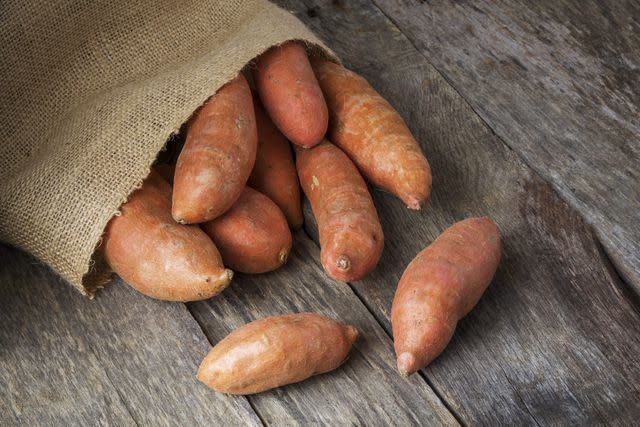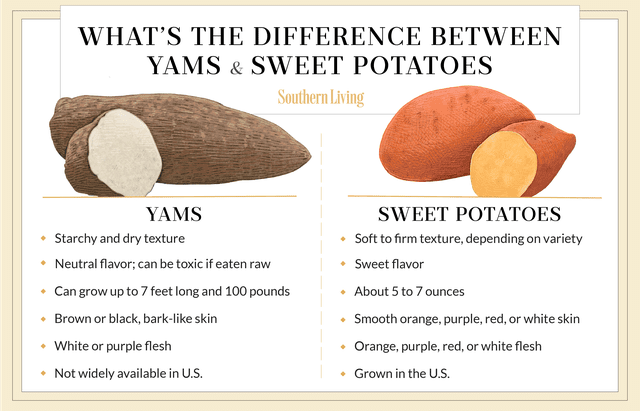What's The Difference Between Yams And Sweet Potatoes?
Wondering about the difference between yams and sweet potatoes? Find out the real answer from sweet potato expert April McGreger.
I was born in Vardaman, Mississippi, the self-proclaimed "Sweet Potato Capital of the World." Since my previous home state of North Carolina produces far more sweet potatoes—about as much as Mississippi and the other top-producing states of California and Louisiana combined—it seems that Vardaman should consider relinquishing this title. They maintain, however, that what they lack in quantity, they make up for in quality. In fact, one Vardaman farmer reported that visiting farmers from North Carolina took Mason jars of his soil back to North Carolina State University in an attempt to decipher the secret to the silky sweet taste and the smoother, tighter skin of Vardaman-grown sweet potatoes.

If there is one question that everyone I meet seems to have, it is the difference between yams and sweet potatoes. The two are used interchangeably in the United States, but they are not the same. Learn how these two vegetables differ.
Meet The Expert
April McGreger is the founder of Farmer's Daughter, a former North Carolina-based artisan food company, and the Fermentation Lab at The People's Kitchen Philadelphia.

History
That confusion is two-fold and centuries old, beginning with the slave trade. Ships transporting enslaved Africans to America were provisioned with true yams (Dioscorea), a large hairy root of tropical origins. In America, where there were no yams, they were replaced with the New World sweet potatoes (Ipomea batatas), which were paler in color and drier in texture than today's popular varieties. Slaves took to calling them by the West African word nyami, which was Anglicized to "yam."
Mislabeled Yams
That confusion was further compounded in the 1930s when the USDA allowed Louisiana to brand the moist, bright orange Puerto Rican variety of sweet potato as a yam, however incorrect that designation may be. By capitalizing on its colloquial name, Louisiana hoped to distinguish its sweet potato from the inferior varieties grown at the time in Virginia, Maryland, and New Jersey. Call them what you wish, just know that in the United States, most vegetables labeled yams are actually a variety of sweet potatoes.
Yams vs. Sweet Potatoes
Yams and sweet potatoes differ in flavor and appearance, and they are not related. Sweet potatoes are in the morning glory family, while yams belong to the lily family. Yams aren't as sweet as sweet potatoes, and they are starchier and drier. Their texture and flavor are more similar to potatoes or yuca. They can grow up to seven feet long and over 100 pounds with brown or black bark-like skin and white or purple flesh. Sweet potatoes can have orange, purple, red, or white skin and flesh. They usually weigh around 5 to 7 ounces.
Where to Find Yams
True yams are becoming more common in the United States, and they can be found at specialty grocers that carry African, Caribbean, or Asian foods. Unlike sweet potatoes, yams can be toxic if eaten raw. To eat, they can be boiled, roasted, baked, or fried. Like sweet potatoes, they prefer cool, dark storage.
How to Substitute
You may not want to substitute true yams in your Candied Yams recipe since their flavor isn't the same as the sweet potatoes in the dish. They can be substituted for sweet potatoes in more savory dishes. Treat them like potatoes to make mashed yams or yam fries.
If you're looking for true yams and can't find them, some varieties of sweet potatoes can be swapped in. While orange sweet potatoes live up to their name, other varieties aren’t as sweet. White sweet potatoes are milder in flavor with a more crumbly texture than regular sweet potatoes. They’re more similar to russet potatoes and are a good choice for roasting or to use in a hash. They may be a suitable substitute for true yams if you can’t find them locally. Purple sweet potatoes also have a drier, denser texture than their orange-fleshed counterparts with a slightly sweet flavor, making them a good choice for roasting and baking. If you see purple potatoes labeled Ube, those are actually true yams.
For more Southern Living news, make sure to sign up for our newsletter!
Read the original article on Southern Living.

